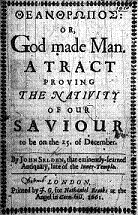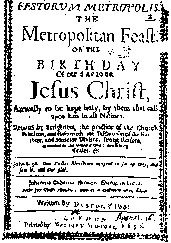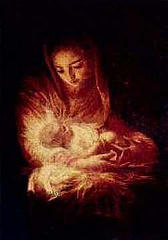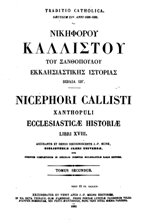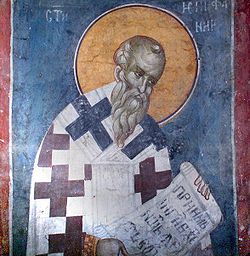The Year of Christ’s Birth Corrected
W. E. Filmer
For many years every discussion
of the date of Christ’s birth has taken into consideration the
belief that Herod the Great died in 4 B.C., so that Christ must have
been born at least that early. This date is supposed to be
absolutely fixed by a lunar eclipse that took place on the night of
12/13 March in that year. Another eclipse of the moon,
however, which met all the required circumstances, occurred on
January
It is not generally realized that most of the Christian writers before A.D. 500 believed that Christ was born in 2 B.C. Superficially they appear to be in hopeless disagreement, but when their statements are examined more carefully, it will be found that the discrepancies depend entirely on how each writer reckoned the regnal years of the Roman emperor Augustus.
Tertullian is representative of an early group of writers who place the birth of Christ in the forty-first year of Augustus. In his Answer to the Jews, written about A.D. 198, he made a number of statements which leave no doubt as to what he meant by the forty-first year of Augustus. He says,
‘Cleopatra reigned jointly with Augustus... 13 years
After Cleopatra's death Augustus reigned... 43 years
for all the years of the reign of Augustus were... 56 years.'
The relevant dates for the reign of Augustus are known from Roman history with absolute certainty. Julius Caesar, assassinated on 14 March, 44 B.C., had nominated Octavius, later called Augustus, as his adopted son and successor. Octavius, however, did not immediately come to power, for Antony at once took charge of the affairs of state, and it was not until early in the following year, 43 B.C., that Octavius received any authority at all. Even then he did not become equal with Antony until he was appointed consul on 19 August. He died exactly fifty-six years later, on 19 August, A.D. 14. Since Tertullian gives him a reign of fifty-six years, he evidently took 19 August, 43 B.C., as the date of his accession.
Regarding the birth of Christ, Tertullian says, ‘When Augustus had been reigning for twenty-eight years after the death of Cleopatra, Christ was born., and the same Augustus survived after Christ was born fifteen years; and the remaining times of years to the day of the birth of Christ bring us to the forty-first year, which is the 28th of Augustus after the death of Cleopatra.’ Now Antony and Cleopatra committed suicide in August 30 B.C., after which Augustus, having already reigned thirteen years over Egypt jointly with Cleopatra, became sole ruler until his death forty-three years later. Tertullian divides these forty-three years into twenty-eight until the birth of Christ, and fifteen years from the birth of Christ until the death of Augustus. This places the birth of Christ at the end of the forty-first year of Augustus; counting from his accession in August, 43, that is at about August 2 B.C. All Tertullian’s statements harmonize perfectly with Roman history, which leads to the conclusion that he was sure of his facts, and knew when Christ was born.
Other Christian writers who lived about the same time give the same date. Irenaeus, about A.D. 180, wrote ‘Our Lord was born about the forty-first year of the reign of Augustus.’ Origen, early in the following century, said that Christ was born in the forty-first year of Caesar Augustus, that Augustus reigned fifty-six years, and that after the birth of Christ there remained fifteen years of his reign. His figures are evidently the same as those of Tertullian, and lead to the same result, namely that Christ was born about August, 2 B.C.
Clement of Alexandria said that ‘Our Lord was born in the twenty-eighth year, when the first census was ordered to be taken in the reign of Augustus.’ Clement, since he lived in Egypt, naturally reckoned the sole reign of Augustus from the death of Cleopatra, and so gives the twenty-eighth year instead of the forty-first.
Julius Africanus, in the first half of the third century, published his Chronographies, in which he said that the number of years from the creation of Adam to the birth of the Saviour was 5500. Whatever may be thought of the earlier part of this work, the latter part, from the time of Cyrus onwards, can be correlated with the Greek calendar, so that the year 5500 from Adam corresponded with the 2nd year of the 194th Olympiad. Since Greek years began on 1 July, the Olympiad year 194,2 was the year that ended 30th June, 2 B.C. But since Africanus was writing in Palestine, he probably used the Jewish calendar in which the year ended three months later. His date for the birth of Christ, therefore, would be before October in 2 B.C., agreeing closely with that of Tertullian.
Hippolytus of Rome, another chronologist of the same period, gave a similar result, but in his scheme Adam was created two years earlier, so he says Christ was born 5502 years from Adam.
Eusebius, one of the greatest authorities on church history and chronology, was the first to place the birth of Christ in the forty-second year of Augustus. However, in this context he said that Augustus reigned fifty-seven years, not fifty-six, which shows that he placed his accession one year earlier. This is confirmed by the fact that he still placed the birth of Christ twenty-eight years after the death of Cleopatra. Thus he says, ‘It was, then, in the 42nd year of the reign of Augustus, and the 28th year after the submission of Egypt and the death of Antony and Cleopatra . . . when our Saviour and Lord Jesus Christ . . . was born.’ Thus the date is once more the same as that given by Tertullian.
In his Chronicle, Eusebius gives Augustus a reign of fifty-six years and six months, thus placing his accession about February, 43 B.C. It was about that time that the young Octavius had first been given a measure of authority by the Roman Senate. The Chronicle places the birth of Christ in the 42nd year of Augustus, and this is equated with the third year of the 194th Olympiad; that is, the year beginning in July, 2 B.C.
Epiphanius, a few decades later than Eusebius, agreed with him that Augustus reigned fifty-six years and six months, and so he says that Christ was born in the 42nd year which would have begun about February, 2 B.C. To clinch matters, he elsewhere dates the Epiphany of Christ in official Roman terms, saying that it was in January of the year in which the consuls were Octavius for the thirteenth time, and Silvanus; this was January 2 B.C. By Epiphany he probably meant conception at the time of the Annunciation by the angel to Mary, which is nine months before the actual birth.
Apollinarius of Laodicea, a contemporary of Epiphanius, said that from the birth of Christ to the eighth year of Claudius Caesar was forty-nine years. Claudius became emperor on 25 January, A.D. 41, so that his eighth year began in January, 48. It follows that, according to Apollinarius, Christ was born in the year beginning January, 2 B.C.
Finally we come to Orosius who compiled a popular history of the world down to the year A.D. 417. He placed the birth of Christ towards the end of the 42nd year of Augustus (VII,2), and elsewhere expressed this date in the conventional terms of Roman times, namely 752 years from the founding of the city of Rome. The year 752 A.U.C. (ab urbe condita) is equivalent to 2 B.C.
Thus there were, before the year 500, no less than ten Christian witnesses who agreed on the year in which Christ was born. Now it might be argued that by no means all these writers can be considered as reliable chronologists; in fact, they disagree widely on other important dates such as that of the Crucifixion. But that only makes their agreement on the birth of Christ the more remarkable, in fact so much so that it demands an explanation. Since they express the date in a variety of different terms, such as regnal years, or A.U.C., it does not look as if they were copying from one another. It suggests that there must have been a common source available to all of them, and this may well have been the record of the census filed in the archives of Rome.
There can be little doubt that
this documentary evidence was actually available for inspection in
the second century, for Justin Martyr, in presenting his First
Apology to the Jews, said that according to
This documentary evidence appears to have been well known to Orosius early in the fifth century. He said that ‘It was also in this year (752 A.U.C.) when God had deigned to assume the appearance and nature of man, that this same Caesar . . . for the first time ordered a census to be taken of each and every province, and that all men should be enrolled. In these days, then, Christ was born and His name was entered in the Roman census list immediately after His birth. This is that earliest and most famous acknowledgment, which designated Caesar first of all men, and Romans lords of the world; for in the census list all men were entered individually, and in it the Maker of all men wished to be found and enrolled as a man among men.’ VI, 32).
The description of the census as ‘this earliest and most famous’ record of the Incarnation, suggests that its existence in the archives of Rome was still well known among Christians, but it may well have been destroyed when the Goths sacked Rome in A.D. 410. By the end of the sixth century its existence seems to have been forgotten, for Orosius was the last to make mention of it.
Anno Domini
The year of the Lord, or Annus Domini, was first used for dating historical events by the Venerable Bede in his Ecclesiastical History of Britain, completed in the year 731. This custom was soon carried to Gaul by British missionaries, and has since become normal usage in most parts of the world. Bede based his A.D. dates on a set of Easter tables that gave the date for Easter Sunday in each year. He had compiled these tables himself by extending some existing tables originally compiled in 525 by a Roman monk or abbot named Dionnysius Exiguus (Denis the Little). These covered the period 532-626, and had meanwhile been extended by another abbot from 627-721. They had been brought to Britain by Wilfred who foisted the Roman Easter on the British church at the Synod of Whitby in 664.
In the original table covering 95 years (or five Metonis cycles of 19 years), Dionysius had numbered the years from 532 to 626 for the first time ‘from the Incarnation.’ Previously other Easter tables had been in use; one, that of Victorius drawn up in Rome, numbered the years from the Passion, or Crucifixion of Christ, erroneously assumed to have been in A.D. 28. Another, compiled by Cyril of Alexandria, numbered the years from the accession of the emperor Diocletian. Dionysius, although otherwise following the Alexandrian rule for finding Easter, and beginning from where the Alexandrian table ended, was unwilling to perpetuate the name of Diocletian, the great persecutor of Christians, so he numbered the years in his new tables ‘from the Incarnation of our Lord Jesus Christ.’
Unfortunately Dionysius left no explanation of how, or on what grounds, he had determined the date of the Incarnation. In whatever manner Dionysius arrived at the date of the Incarnation, he must have made an error by making assumptions for which no support can be found in historical records. The starting date of the commonly used Christian era appears, therefore, to have been founded on nothing better than tradition, superstition, or error, and it has long since been rejected by all responsible historians.
Reprinted from the National Message Magazine
___________________________________
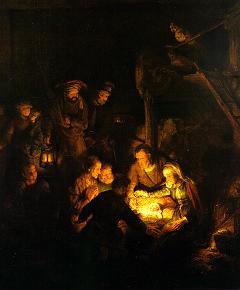
Adoration of the Shepherds
All rights reserved.
 John Seleden’s
John Seleden’s